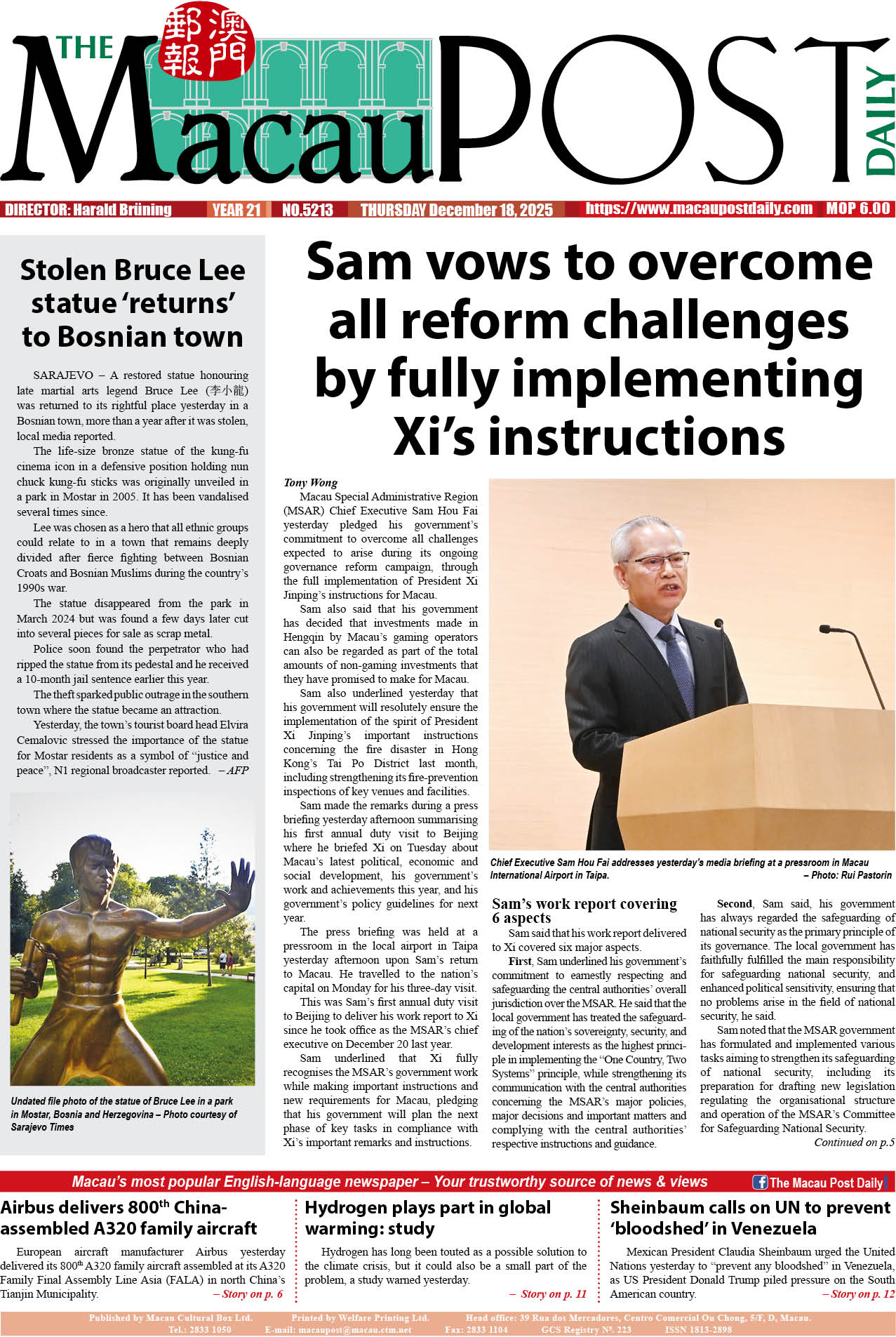Luiz Inácio Lula da Silva is paying a state visit to China this week that, I am confident, will not only further strengthen the close bilateral ties between the two countries but also the relationship between China and Latin America including the Caribbean.
Brazil’s 39th head of state and government (the South American country is a presidential republic where the president is vested with strong executive authority precluding for a prime minister) is a former metal worker and trade union leader mononymously known as Lula, his childhood nickname for Luiz* which he later added to his surname.
Lula, who will be 80 in October, can confidently be described as an “old friend” of China among the leaders of the world’s major countries. He served two consecutive four-year terms at the helm of Brazil’s quite robust presidential system between 2003 and 2011 (the maximum two-consecutive presidential terms allowed by the Constitution of the Federative Republic of Brazil) and again had been president since 2023.
Both Lula and President Xi Jinping attended the 80th Anniversary Victory Day Parade on Moscow’s Red Square among dozens of other world leaders or their representatives. The fact that Xi and Lula were present proved that their and many other countries, in the Global South in particular, are increasingly pushing back against the West’s attempted diktat on global policies, asserting their right to self-determination.
While the political systems of Brazil and China are different, they are obviously united in defending the rights and interests of the developing world, aiming to ensure a fair and multipolar global order after decades or even centuries of exploitation and marginalisation.
Xi and Lula do, however, have one thing in common – both are the world’s poverty alleviation champions, for which I hold them in high esteem.
Lula and Xi will hold bilateral talks in Beijing tomorrow. Xi is also slated to address the opening ceremony of the 4th Ministerial Meeting of the China-CELAC (Community of Latin American and Caribbean States) Forum in Beijing tomorrow, a spokesperson for the foreign ministry announced yesterday.
Foreign ministers or their representatives from the CELAC countries, and heads of relevant regional organisations will attend the meeting, the spokesperson said.
The 33 CELAC member states have a population of 660 million. China and the CELAC countries represent one-quarter of the world population. The Global South, which includes China and CELAC, has a share of 85 percent. Simple arithmetic shows that the West (North America, Europe, Australia, New Zealand, Japan and South Korea) with just 15 percent of the global population, will find it increasingly difficult to dominate the other 85 percent of humankind much longer, such as by trying to impose the values of its inherently disruptive and ultimately alienating woke culture on the huge majority of the international community that have their very own millennia-old value systems.
In a congratulatory message to the 9th CELAC summit in the Honduran capital Tegucigalpa last month, Xi underlined that Chinese relations with the 33-nation bloc “have withstood the test of international turbulence and entered a new stage marked by equality, mutual benefit, innovation, openness and tangible benefits for the people”.
Xi has been paying close attention to China-CELAC ties since he became president in 2013.
“True friends always feel close to each other no matter the distance between them,” Xi has said, citing an ancient Chinese adage to characterise China’s relations with countries in Latin America and the Caribbean.
Since becoming head of state, Xi has flown six times across half of the globe to Latin America and the Caribbean, visiting a dozen countries in the vast region. “There, he met national leaders, witnessed the signing of cooperation deals, visited local farms, sipped Costa Rican coffee and was gifted an Argentine soccer jersey with his name on it ...,” Xinhua writer Ma Qian pointed out in a commentary last November.
Similarly, Lula da Silva has steadfastly sought to improve his country’s ties with China since moving back into Planalto Palace (the workplace and residence of Brazil’s president in the capital Brasília) in early 2023.
While China is CELAC’s number-two trading partner, after the US, is has been Brazil’s top trade ally since 2009 – that’s a pretty long time! Brazil mainly exports soybeans and other primary commodities to China, while the latter ships mostly industrial goods to its South American friend.
Brazil is one of the 10 members of the Macau-based Forum for Economic and Trade Cooperation between China and Portuguese-speaking Countries, also known as Forum Macao, which was established by the Ministry of Commerce (MOC) in 2003 in conjunction with countries where Portuguese has official language status.
Trade between China and CELAC is quite diverse, covering both primary commodities and manufactured goods, including China-made railway equipment, household appliances, garments, footwear, computers, mobile phones and a wide range of other manufactured goods, while CELAC member states’ exports to China still mainly consist of raw materials and other commodities. But China is not just a trader with but also a major investor in Latin America and the Caribbean.
China has significantly expanded its investments in CELAC over the past two decades, focusing on infrastructure, energy, mining, and technology, which increasingly includes high tech. Economists estimate that China’s investments in CELAC countries have created millions of jobs. These investments are part of China’s Belt and Road Initiative (BRI). China has also become a major financier and builder of Latin American and Caribbean infrastructure. The list of the completed, ongoing and projected projects would cover several pages of our newspaper, so I can only mention some of them, such as the Port of Chancay in Peru and the Port of Moín in Costa Rica, the proposed Belém-Rio de Janeiro Railway and Bi-oceanic Corridor connecting Brazil, Peru and Bolivia by railway, the Bogotá Metro project in Colombia, the large-scale Cauchari Solar Park in Argentina and a large number of wind farms in Brazil, 5G networks by Huawei despite US pressure, the provision of loans by the China Development Bank & Exim Bank worth billions of US dollars.
China-CELAC trade and investment ties remain based on the cardinal principles of the Belt and Road Initiative (BRI) – “win-win cooperation,” “mutual benefits,” and “shared gains.”
These principles reflect China’s commitment to fostering global connectivity, economic development, and mutual prosperity through infrastructure projects, trade, and cultural exchanges.
A recent article on China-CELAC ties signed by international affairs commentator Xi Pu pointed out that both China and Latin American boast somehow similar millennia-old symbols of wisdom – the Chinese Dragon known as “Lóng” (龍) and Mesoamerica’s Quetzalcóatl (“Plumed Serpent”) divinity associated with creation, agriculture (credited with bringing maize to humanity), learning, wisdom and, last but not least, civilisation. Latin American researchers have pointed out the mythical similarities between both. I should add that, contrary to the West where dragons are mostly regarded as malevolent creatures, in China and elsewhere in the East dragons are seen as benevolent beings and bringers of harmony.
Well, seeking wisdom and harmony is what’s most needed right now, considering the socio-economic-political state this fragile planet is in right now.
The CECAL member states’ main languages are Spanish, Portuguese and English (the latter mainly as the region’s lingua franca and language of trade, investment, technology and science), apart from a rich variety of indigenous languages.
Secretary for Administration and Justice André Cheong Weng Chon told lawmakers last month that Macau and Hengqin will jointly establish a service centre for economic and trade cooperation between China and Portuguese- and Spanish-speaking countries, scheduled to start operating in the second half of this year.
That’s great news at just the right time! As someone who has gone through the trouble (or pleasure, depending on how you look at it) of studying both languages, I would like to point out that both are quite similar but also rather different. Both Iberian languages have around 90 percent lexical similarity so that they are mutually intelligible to a large extent. Let’s clarify what is at stake here – practical communication to facilitate trade, investment and cooperation as we are not aiming for literary greatness here.
Macau’s schools and universities should waste no time in setting up Spanish-language courses.
I agree with Portuguese Consul-General Alexandre Leitão who said on the sidelines of Saturday’s function marking the opening of consular services here by the Spanish-speaking Oriental Republic of Uruguay, which abuts Brazil, that Macau’s aim to strengthen its ties with the Spanish-speaking world should be seen as a natural consequence of its ongoing effort to advance the local economy’s appropriate diversification.
Nearly 900 million people speak Spanish and Portuguese (native and non-native speakers), or around 11 percent of the global population. That’s massive.
Chief Executive Sam Hou Fai met with Uruguayan Foreign Minister Mario Lubetkin, who was paying a working visit to Macau on Saturday. The right meeting at the right time.
The outreach to the Hispanic world is pertinent to fostering Macau’s role as a platform for commercial and cultural relations between China and the Portuguese- and Spanish-speaking world. Some 30 countries and territories in the world have Spanish and/or Portuguese (Spanish and Portuguese are official languages in Equatorial Guinea, the only country where both languages have official status) – that’s a huge market on four continents. Let’s make good use of it – for the benefit of the whole country!
– Harald Brüning
*Such as “Bill” for “William”








